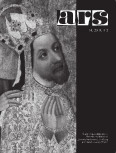
Časopis ARS 51 (2018) 1-2
Tomáš KOWALSKI
Majster, pomocníci a dielňa: Anton Cyril Glatz a Majster Pavol z Levoče
(Resumé)
The chief personality of Slovakiaʼs Late Gothic wooden sculpture, Paul of Levoča (Paul Schnitzer), has been the subject of research by art historians for many decades. The most common questions concern the origin of Paulʼs style, the extent of his own work and the participation of his workshop adjuncts or followers. One of the prominent art historians in Slovakia, Anton Cyril Glatz, devoted himself to the artistic heritage of his homeland Spiš (Scepusia, Zips), where he was born on 5 July 1945. The environs of his region and native municipality of Spišská Sobota (Georgenberg) inspired him to become an art historian. He graduated from the Charles University in Prague in 1968 with a thesis entitled “Gothic Wooden Sculpture of Spiš in the 14th century,” supervised by Professor Jaromír Pešina. Glatz started his professional career as a conservationist in the East Slovak regional heritage institute, where he participated in the inventorying of monuments. His wider knowledge of the region’s art history significantly helped to complete the exhibition project “Sacred Art in the History of Visual Arts of Spiš” (1969). In 1971, the Slovak National Gallery (SNG) director, Ján Hraško, invited Glatz to become a custodian of the Gothic art collection. It was just in the early 1970s that the acquisitions gained by the SNG from the former church properties grew. The curated collection was researched and catalogued by Glatz in 1973–74. Until 1980, he wrote similar catalogues of Gothic Art kept by important museums in Slovakia. The SNG collection also contains several sculptures of Spiš provenience, which were analysed by Glatz as a prelude for Paul of Levočaʼs style, which he later developed in carvings such as the female saintsʼ figures of Okoličné, or the Csáky Madonna from Levoča. At the very end of his life, Glatz dealt with the major work of Paul of Levoča – the high altar of St. James, constructed and sculpted until 1508. In his highly appreciated and detailed analysis Glatz searched for the sources of inspiration for sculptures and reliefs, as well as tabular paintings; the first ones being combinations of various models from graphics by Master E. S., Martin Schongauer, Israhel van Meckenem Jr., and Michael Wolgemut. The domestic origins of the style and compositions of Paul’s early sculptures were identified by Glatz in the works of “Master of the Altar of Virgin Mary of the Snows” (1496). Paulʼs origin from Spiš speaks to his close relation to older artistic traditions in Levoča. Glatz found other possible sources of sculpted figures and compositions in œuvre of Tilman Riemenschneider (Altar of the Farewell of the Apostles, delivered to Kornburg near Nuremberg, 1491; Holy Blood Altar, St. James Church in Rothenburg ob der Tauber, 1501–05), and various works in Swabia and Franconia. Such investigations are truly different in comparison to the “romantic” beliefs of all of the previous literature. The reintegration of Apostle figures, originally from the previous high altar (ca. 1380), is regarded as the citizensʼ manifestation of piety, tradition and reverence to ancestors. Already in his thesis (1968), Glatz reconstructed the composition of the former altar, based on the St. Cosmas and Damian altar for Šiba (Šariš region), now in the East Slovak Museum in Košice. Paulʼs workshop in Levoča produced a number of altars, Calvary compositions and crucifixions, preserved in various locations in Spiš and especially in the more eastern region of Šariš. The later altar works of the 1510s and 1520s are decorated by a spectrum of motifs originating from Augsburg and Viennese workshops influenced by the Italian Renaissance. Glatz devoted special attention to the “constructing” of various adjuncts and followers of Paul. Such an approach was certainly determined by his practice as a museum curator and an expert focused primarily on the questions of the ‘style’ of the artwork. Eventually, this method helped him to categorize a number of until now anonymous works preserved in the state and private art collections of Slovakia. On the other hand, his catalogues of collections did not allow him to build up a more global view on this topic. Since his first publications, Glatz had in his mind an idea of synthesis based on a detailed analysis of the Gothic wooden sculptures preserved in the territory of Slovakia. However, his concept was never put into practise due to his premature death in 2001. The Slovak National Gallery representative project dedicated to Gothic art, History of Slovak Fine Arts, of which Glatz was the first leader, was later accomplished in cooperation with art historians invited from abroad and in a completely different way. It is worth of noting that it would be difficult to complete it without his meticulously written texts.